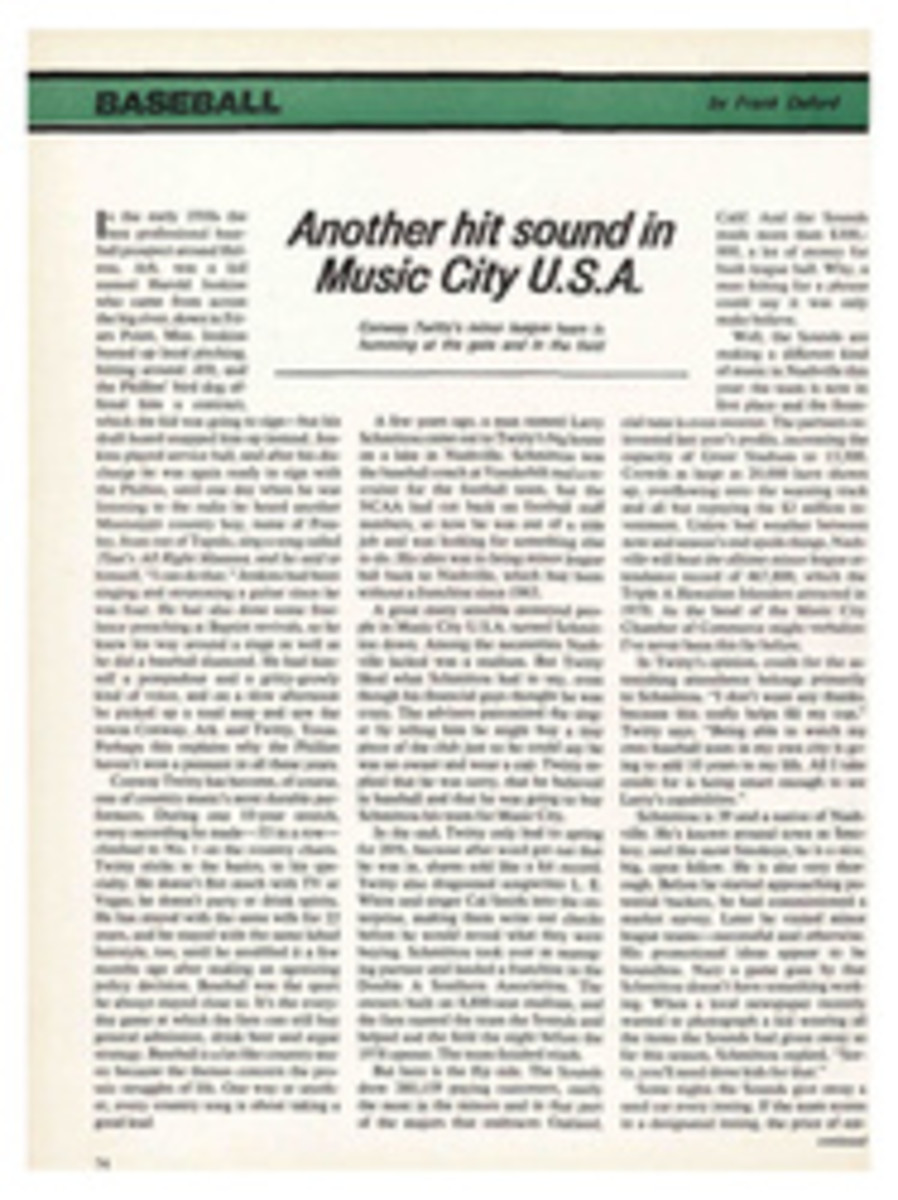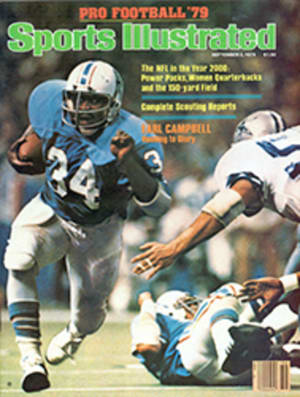
AFC West
Can Denver make it three straight division titles? Will San Diego's 14-year drought end? Can Oakland come back? Is Seattle for real? Will Kansas City throw a pass this season? Welcome to the forecast-defying AFC West, where predicting a four-team dead heat wouldn't be that outrageous.
The keen balance of the NFL's most competitive division was evident a year ago when Oakland, Seattle and San Diego each finished with a 9-7 record behind Denver's 10-6. Kansas City brought up the rear at 4-12. A season of even closer infighting seems certain in '79. By the time these teams have finished slicing each other up, no also-ran is likely to have a record good enough to make the playoffs as a wildcard entry. And unless SAN DIEGO is hurt further by the kind of injury that cost it the services of Louie Kelcher, its finest defensive lineman, look for the Chargers to take their first title of any kind since the pre-merger days.
San Diego's strengths lead off with the NFL's best passing attack, a five-receiver celebration of wide-open offense that made the Chargers winners in seven of their last eight games a year ago. An explosive attack is the trademark of Coach Don Coryell, who deploys his receivers to overload man-to-man defenses and stretch zone coverages to the breaking point. "Toward the end of last season," says Quarterback Dan Fouts, "the defenses didn't know where we were going to hit them next. We really turned it on."
San Diego can—and often does—throw deep to John Jefferson, a burner who caught 56 passes for 1,001 yards and 13 touchdowns—most by an NFL receiver in '78—and his outside running mate, Charlie Joiner. Tight Ends Bob Klein and Kellen Winslow, the Chargers' No. 1 draft choice, are also dangerous on the medium and deep routes, and if the coverage prevents the long pass, Fouts can always dump the ball off to Lydell Mitchell, the one-man gang. Mitchell, who spent most of training camp recovering from a staph infection in his right knee, rushed for 820 yards and caught 57 passes for 500 more in 1978.
Now in his seventh season, Fouts is the man who ignites the Chargers' explosiveness—and few clubs have a better detonator. By completing 59% of his passes for 24 touchdowns and 2,999 yards, Fouts last year demonstrated that his arm is one of the NFL's best. He also eliminated any doubts about his leadership qualities, if not those about his durability. He resents being considered fragile, but while he was out for only 1½ games last season, during his career he has missed 14 games because of injuries. Fouts is the one player San Diego can't afford to lose. His backup is 32-year-old James Harris, who is neither the thrower nor the leader to take the Chargers to a title.
Moving the ball on the ground remains San Diego's biggest offensive weakness—the Chargers ranked next to last in the AFC in rushing in '78—even though an off-season trade brought Running Back Mike Thomas from Washington. Coryell hopes to get improved performances from Don Woods, the 1974 Rookie of the Year who seems to have overcome all his nagging injuries, Artie Owens and Hank Bauer.
The loss of Kelcher was a devastating blow to a defensive unit that had 54 sacks but ranked 15th against the rush and allowed 23 touchdown passes. Despite the addition of outstanding Cornerback Willie Buchanon, acquired from Green Bay, San Diego's best defense will remain its good offense. That attack is made even more potent by Rolf Benirschke, the NFL's No. 2 place-kicker last season, who donates $50 to the San Diego Zoo for every field goal he makes. A zoologist himself, Benirschke enriched the animals by $900 last year.
"I don't think San Diego is strong enough to win, no matter how many people they seem to think they have," one player said of the Chargers. "They're not as good as we are. We're better this year than we've ever been."
That was Lyle Alzado speaking four days before he quit DENVER, saying he was going to embark on a boxing career. Four days after that, Alzado was traded to the Browns. Alzado's departure doubly hurts the Broncos; not only have they lost a team leader but also the most flamboyant member of their three-man line, whose main job is to tie up blockers while the linebackers, led by Randy Gradishar, make the tackles. Even so, Alzado led Denver in sacks with nine and recorded 77 first hits a year ago, when Denver gave up fewer points (198) than any team except Pittsburgh.
In spite of Alzado's absence, Denver's defense will be strong enough. The Broncos lost five games by a total of 14 points last season and only once were beaten by more than a touchdown. The linebacking crew, featuring Gradishar and Tom Jackson, is the NFL's fastest and Cornerback Louis Wright and Safety Bill Thompson are first rate.
Denver's offense is a sad story. Craig Morton, 36, has reverted to the mediocrity of his New York Giant seasons, and Norris Weese, 28, is none too strong a passer, in distance or physique. And whatever effectiveness the quarterbacks might provide is diminished by a line that gave up 48 sacks last year. Miller, an old line coach himself, hired Whitey Dovell—formerly of the Colts—to work with the linemen, but shortcomings up front still were evident in the exhibitions, as the Broncos rarely held off the rushers on predictable passing downs. The running game is not overpowering—and was vitiated when Rob Lytle injured a knee, sidelining him indefinitely—and the kicking must improve. Jim Turner booted only 11 field goals last season.
Don't bury OAKLAND yet. New Coach Tom Flores has a team in transition that may well surprise the entire NFL. For one thing, Kenny Stabler should be a better quarterback than he was a year ago, when his 30 interceptions were the league's most publicized stat. No longer handicapped by the arm injuries that prevented him from throwing long, Stabler again will be the prime mover in an offense that can score from any distance. It can, that is, if the Raiders' line comes through with a more consistent performance than it did in 1978, when Oakland too often found itself in third and long and Stabler was forced to throw more passes (406) than ever before. Blocking is Flores' most worrisome concern, especially because the return of Right Tackle John Vella, out for almost two seasons with knee and chest injuries, has been offset by the loss of Left Tackle Art Shell, who hurt a knee in training camp and will miss at least four games. Also, Tight End Dave Casper's preseason training consisted of playing softball for Willie Nelson's Texas Yazoos, not catching passes from Stabler.
Mark van Eeghen, who is going for his fourth straight 1,000-yard season, will be the mainstay of the ballcarriers, who are, all in all, more than adequate.
Oakland's defense should be better as a result of the trade that brought Dave Pear from Tampa Bay to play nose guard in the three-man front. Cornerback Monte Jackson, who cost the Raiders a pair of No. 1 draft choices, rarely displayed his All-Pro credentials in 1978, but he had a good camp, and Ted Hendricks remains a role model for NFL linebackers. But there may be a glaring weakness in the line if, as it appears, massive Tackle John Matuszak has reverted to the undisciplined and unbridled Matuszak who flunked out in Houston, Kansas City and Washington.
That sort of concern is foreign to SEATTLE, a team whose off-field behavior would not embarass a Sunday school class. On the field, however, the Seahawks have made fast improvement during their four-year history and will contend for a playoff spot, even if they wear the NFL's ugliest uniforms.
Now that Fran Tarkenton has become a TV analyst, Seattle's Jim Zorn is the finest improvisational quarterback in the game; he was the AFC leader in completions (248) and passing yardage (3,283) in 1978. Zorn's scrambling is not only effective but necessary, because the Seahawks are blessed with neither an imposing tight end nor unfailing interior linemen. Seattle's assets include Steve Largent, a Pro-Bowl receiver who hauled in 71 passes for 1,168 yards despite a deficiency in speed, and an efficient rushing attack paced by Dave Sims and Sherman Smith. Sims led the NFL in touchdowns last season with 15 and combined with Smith for 1,557 yards.
The Seahawks' biggest question mark is a defensive unit in search of a line. Last year Seattle ranked 23rd against the rush and 27th against the pass, and gave up more points than every team save the Jets. Coach Jack Patera is counting on pass-rush help from veteran End Carl Eller and Tackle Manu Tuiasosopo, the No. 1 draft choice.
Kansas City is the only non-contender in the division, but the Chiefs will spoil some Sundays for their opponents if Coach Marv Levy can add effective pass plays to his rush-oriented Wing-T. The Chiefs virtually ignored the pass last season when their runners, led by Tony Reed's 1,053 yards, ranked second in the NFL and rambled for an average of 186 yards a game. Except when playing catch-up, Kansas City's passing game will be strictly play action, unless rookie Steve Fuller unseats 12-year-veteran Mike Livingston at quarterback.
On defense, the Chiefs are still rebuilding and will again suffer from youthful mistakes and the lack of a pass rush. Defensive End Mike Bell of Colorado State, the team's No. 1 draft choice, may help the latter now that he's recovered from off-season knee surgery.
ILLUSTRATION
Winslow: A charger for the Chargers.
ILLUSTRATION
Tuiasosopo: A hunter for the Seahawks.
Predicted Finish
SAN DIEGO 10-6
DENVER 9-7
OAKLAND 8-8
SEATTLE 8-8
KANSAS CITY 4-12

